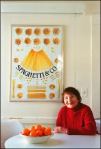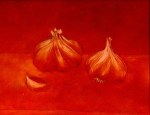Archive for the ‘Culinary Writers’ Category
Cooking in Ten Minutes by Edouard de Pomaine.
“Do not imagine that ten-minute cooking is going to condemn you to an eternal round of beef-steak without any of the frills of finer cookery.
Your gas stove has two burners, if not three. What is to prevent you cooking slices of ox kidney saute’ in butter on the one, while you make a sauce bearnaise on the other?
During the same ten minutes you can prepare both the kidneys and the sauce. The result is delicious. I have done it time and again. Thanks to the sauce the ordinary ox kidneys, despised by the fastidious, assume an aristocratic manner.
You can always prepare meat and a sauce, but are there many rapidly prepared sauces? That all depends on the liveliness of your imagination. Invent the sauces. The great thing is to prepare them quickly, and for this you must follow the advice which I shall give you for the preparation of some standard sauces.”
~~~~~
Here’s what Elizabeth David wrote about Pomaine in her book An Omelette and a Glass of Wine. [pp. 175-182]
“In the days when Pomaine was writing, chefs did not dream of braising vegetables – lettuces, leeks, Belgian endives, for example – without a preliminary blanching. That rule was immutable, and woe betide anyone who disregarded it. Dr. de Pomaine bypassed it, and I adopted his method, particularly his recipe for cooling Belgian endives in butter and entirely without a prior water baptism. That sort of unorthodoxy got one into trouble. …
Doctor Edouard de Pomaine’s real name was Edouard Pozerski. He was of purely Polish origin, the son of emigres who had fled Poland and settled in Paris after the Revolution of 1863. …
De Pomaine was the first writer to propound such happenings as the fusion of egg yolks and olive oil in a mayonnaise, the sizzling of a potato chip when plunged into fat for deep-frying, in language so straightforward, so graphic, that even the least scientifically minded could grasp the principles instead of simply learning the rules. In cooking, the possibility of muffing a dish is always with us. Nobody can eliminate that. What de Pomaine did by explaining the cause, was to banish the fear of failure.
Adored by his public and his pupils, feared by the phoney, derided by the reactionary, de Pomaine’s irreverent attitude to established tradition, his independence of mind backed up by scientific training, earned him the reputation of being something of a Candide, a provocative rebel disturbing the grave conclaves of French gastronnomes, questioning the hold rites of the ‘white-vestured officiating priests’ of classical French cookery.
Of a dish from the Swiss mountains, Dr. de Pomaine observes that it is ‘a peasant dish, rustic and vigorous. It is not everybody’s taste. But one can improve upon it. Let us get to work.’ … ”
Resources:
The following text is an excerpt from The Atlantic, Corby’s Table , 2002.05.01, a book review written by Corby Kummer. I use this excerpt in classes on Food Writing that I teach online for UCLA, and at other venues, as an example of how to write an engaging book review and display the essence and motivations of the author.
Corby Kummer’s voice starts here, commenting on Barbara Haber and her book From Hardtack to Home Fries:
Not all women like to cook, of course. But like it or not, most women’s lives are entwined with food.
The recognition that food and everything having to do with it can offer perspective on many aspects of women’s lives led Barbara Haber to build the culinary collection at the Schlesinger Library at Radcliffe into a powerhouse of women’s studies. In the thirty years since Haber arrived in Cambridge, from Milwaukee by way of the University of Madison with a degree in library studies, the collection has become a magnet for scholars, journalists, and cooks. The Schlesinger is now a national touchstone for anyone interested in food, not just because it houses the books and papers of Julia Child, M.F.K. Fisher, and Ella Fitzgerald (an enthusiastic cook, it turns out), among many others, but because Haber herself is so magnetic.
She’s also a terrific speaker. I’ve long gone out of my way to attend any lecture Haber is giving, knowing that whatever the subject I’ll gain insight into a whole culture as well as the women who were active within it. Through first-person accounts, contemporary books and sources, and her own witty and sharp comments, Haber brings times and places alive. Hearing her on the social structure of the harem at Topkapi, for instance, altered my understanding of the cruel beauty of the Ottoman empire. (Haber and I were on the eve of a trip to Turkey organized by Oldways, the Cambridge-based food think tank; everyone should be able to listen to Haber at the start of a journey.)
From Hardtack to Home Fries offers a collection of nine wonderfully readable essays on an unexpected range of topics that have captured Haber’s interest. Every reader will have her or his favorites. I know that Haber herself is particularly proud of her essay on Mrs. Henrietta Nesbitt, the cook who made famously bad food in the White House of Franklin and Eleanor Roosevelt. More than just a terrible cook, Haber finds in her a woman Mrs. Roosevelt valued as a helpmeet, one who cared about the President’s health and about running a sensible household. Julia Child liked that chapter, too: in a sign of her regard for Haber, she wrote a warm endorsement for the back cover after decades of blanket refusals to blurb any book.

Uniform worn by women who worked for the Harvey Restaurants serving railroad travelers at stops in the western USA.
My own favorite is a chapter on the Window Shop, a bakery, restaurant, and sui generis social-service agency for genteel Jewish refugees who arrived on the academic shores of Cambridge starting in the late 1930s. The oral and written histories Haber collected yield a portrait of a turbulent and fascinating time, along with a good recipe for Sacher torte. I was also pleased to learn about the Harvey Girls—those white-aproned purveyors of good food and rectitude along the Atchison Topeka and Santa Fe Railroad, in a chapter of special charm that recalls a rough and just-civilizing time in our not-so-distant past. A chapter on the early diet gurus Sylvester Graham and John Henry Kellogg offers a crackling (even snapping and popping) account of an odd turn in American health, which gave us our national breakfast not to mention ideas about diet both sensible and peculiar.
Barbara Haber keeps her focus on women’s relationships to food—especially as it pertains to personal finances. She chronicles how several women found dignity, livelihoods, and their own identities by starting catering businesses and restaurants. A lovely last essay tells how she herself came to collect and study cookbooks; it also shows a touching understanding of her own relationship to her mother. An exceedingly valuable appendix includes notes on the many books mentioned throughout, with a bonus of many more recommendations. These capsule reviews are manna for any aspiring food and social historian. They offer a generous taste of the wealth of knowledge Haber has always freely shared.
There are a few recipes, too—ones I’d like to make. “A modified Graham bread” shows what the health-promoting Sylvester Graham really had in mind: whole grains made appealing and somewhat sweet as a kind of bread, rather than just a sweet cracker for a campfire concoction with marshmallow and chocolate (although really, is there a better dessert than S’mores made over an open fire?). Gekochtes Rindfleisch, or boiled beef, sounds dull, but in the hands of the Viennese émigrés eking out a living at the Window Shop, it was a feast reminiscent of home. A feast it is, with its rich broth and fresh vegetables, and also a way of turning a humble cut into a one-dish meal that can last many days by being served as a soup or main course. Finally, baked fudge is an easy confection that demonstrates why Cleora Butler, the recipe’s author, became a Tulsa legend as a talented businesswoman and cook. Like many of the women Haber discerningly chose, she turned her culinary skills into a way of supporting herself and her family.
—By Corby Kummer
Endless Feasts — Sixty Years of Writing from Gourmet
- Ruth Harkness munching on exotic pheasants left in a Tibetan Lamasery by monks fleeing the Chinese invaders in 1944 because that’s all the food she had.
- Novelist Pat Conroy in Umbria rediscovering the food and sights through the eyes of his new mate.
- The demise of the Ritz-Carlton Hotel in New York as told by Louis DiaGou, the chef who was ran the kitchen in 1910 when the hotel opened and was still there when it closed in 1950.
These are just three of the 41 narratives from the late, great Gourmet magazine. My grandmother wrote a few articles for Gourmet in the 1940s-early 50s.
I wonder…. do travelers possess innately complex palates that drive them to sample the world’s cuisines? Or, does travel expose people to exotic — perhaps fresher — ingredients, unusual preparations and intriguing cultural traditions?
The interplay between food and travel is logical. Go traveling and you’ll be foraging, whether at the street market in Ho Chi Min City, the Ritz in Paris, a Bayou gumbo shack, or at Havana, North Dakota’s community run Farmer’s Inn.
Travelers do develop faith in food; a meal is reward for a long day or night’s journey. Sometimes the story is how grand that meal; other times, how bad, and the aftermath. These stories are nearly all about the great meals and the iconoclasts who cooked them. A few stories include recipes.
Details on the book: Edited and with an introduction by Ruth Reichl. Modern Library, 2002. 401 pages, no index, $24.95
A similar version of this article appeared in the Bloomsbury Review.
What fun to find, by chance, that the Gastronomica Reader ,which includes my long article about Diana Kennedy and Mexican organic farming, is featured in a biblio encyclopedia run by an Estonian webarian! Fun because this connects directly to last week’s Wikimania 2012 in Washington, DC where I met the wikipedian from Estonia, Raul Veede.
Synchronicity and random serendipity are the indicators I follow in order to avoid the contrived pressures of marketing, crowd control, issues management, individual greed and social aggression. Long live the randomness of the internet and the global volunteer efforts of wiki writers everywhere who are the activist-intellectual descendants of Thomas Paine.
Oldways is a non-profit culinary history organization based in Boston with a global outlook.
In 2011, Oldways initiated the K. Dun Gifford award for food journalism. Affiliated reporters, freelancers and bloggers are eligible to enter.
2011 Food Blogs and Websites
- http://www.outlawcook.com — AKA Simple Cooking
- http://www.appetiteforbooks.com — Appetite for Books — Book Reviews
- http://www.chowhound.com — Chowhound –an eater’s forum/ website
- http://fortheloveofcooking-recipes.blogspot.com/ — For the Love of Cooking
- http://www.davidlebovitz.com/ — Living the Sweet Life in Paris
Washington DC specific:
- http://capitalspiceblog.com/ — Capital Spice
- http://www.dcfoodies.com/ — DC Foodies
- http://thriftydccook.blogspot.com/ – Thrifty DC Cook
Culinary Historians of Washington DC looks into the history of food habits, culinary practices, recipes, cultural quirks and people who cook. Washington Post Express recently published an article about C.H.O.W.
members. So what do culinary historians do with their time? Cook, scour pots and eat. They also delve into the history of food preparation, recipe writing, cookbooks, cooking styles and kitchen implements. At each C.H.O.W. meeting there’s a table of cooking gadgets that people have brought in for discussion and i.d. by other members.
http://www.facebook.com/pages/Culinary-Historians-of-Washington-DC/159448224077301
During the coast to coast walk across France, I could eat dessert with every meal. And for breakfast. The story of my solo trek and the meals I enjoyed in the Pyrenees region is between covers now and includes recipes. Kindle version is also available. 
Crème Catalan
4 egg yolks
4 tbsp granulated sugar
2 tbsp flour
4 cups milk
half a stick of cinnamon
fresh lemon rind, grated
1/4 cup superfine granulated or caster sugar for caramelized topping
4 ceramic ramekins or a shallow ceramic serving dish
Beat the egg yolks in a bowl with the granulated sugar. In a shallow bowl, mix the flour with a little milk to make a paste. Pour remaining milk into a saucepan, add the cinnamon stick and grated lemon rind and bring to a boil, then remove the pan from heat and let the perfumed milk cool. Strain the perfumed milk onto the paste mixture in a non-reactive sauce pan (stainless steel, glass or enamel) and heat gently, stirring constantly. The mixture should thicken and when it comes to a boil, pour the crème (custard) into a shallow oven proof dish or into small ceramic serving dishes. Just before serving, sprinkle the top of the custard with superfine sugar and gently burn the surface with a chef’s torch if you have one, or pass the ramekins under the broiler for a few seconds until the top of the custard is browned and sealed with the sugar.
Allen, Gary. (1999) The Resource Guide for Food Writers. New York: Routledge. ISBN 0-415-92250-x
Allhoff, Fritz and Monroe, Dave, Editors. (2007) Food & Philosophy – Eat, Think and be Merry. Oxford: Blackwell Publishing. ISBN 978-1-4051-5775-9
Cronin, Isaac. (1999) The Mindful Cook – Finding Awareness, Simplicity, and Freedom in the Kitchen. New York: Villard Books. ISBN 0-375-50275-0
Jacob, Dianne. (2005) Will Write for Food. The Complete Guide to Writing Cookbooks, Restaurant Reviews, Articles, Memoir, Fiction and More. New York: Marlowe and Co. ISBN 1-56924-377-8
Pitzer, Sara. (1984) How to Write a Cookbook & Get It Published. Cincinnati: Writer’s Digest Books. ISBN 0-89879-132-4
Appetite for Books — cookbook reviews
Selected Reading List::Literary Non-Fiction, Biographical and Autobiographical Writing with a Culinary Focus
Aresty, Esther B. The Delectable Past. Simon and Schuster. 1964.
Beard, James. Beard on Food. Alfred A. Knopf, 1974.
Behr, Edward. The Artful Eater. Atlantic Monthly Press, 1992.
Bemelmens, Ludwig. La Bonne Table. Simon and Schuster, 1964.
Brillat-Savarin, Anthelme. The Physiology of Taste or Meditations on Transcendental Gastronomy. Translated by M. F. K. Fisher. Arion Press, 1994. (original translation copyright 1949, The George Macy Cos. Inc.)
Clark, Robert. James Beard, A Biography. HarperCollins, 1993.
Colwin, Laurie, More Home Cooking, A Writer Returns to the Kitchen, HarperCollins, 1993
Conrad, Barnaby, Absinthe: History in a Bottle, Chronicle Books, 1988.
Critchley, Laurie and Helen Windrath, editors. Feast! Women Write About Food. Distributed by Trafalgar Square, N. Pomfret, VT. The Women’s Press, UK 1996.
Cronin, Isaac. The Mindful Cook. Finding awareness, simplicity, and freedom in the kitchen. Villard, 1999.
David, Elizabeth. An Omelette and A Glass of Wine, Lyons & Burford, 1997
David, Elizabeth. South Wind Through the Kitchen. The Best of Elizabeth David. North Point Press, 1999.
Davidson, Alan. A Kipper With My Tea, North Point Press, 1990
de Pomaine, Edouard. Cooking in Ten Minutes
Dorenberg, Andrew and Karen Page. Dining Out. John Wiley & Sons Inc. 1998
Dumas, Alexandre. Dumas on Food. Selections from Le Grand Dictionnaire de Cuisine. Translated by Alan and Jane Davidson, Oxford Univ. Press, 1987.
Fisher, M.F.K. Stay Me, Oh Comfort Me, Journals and Stories, 1933-1941.
Pantheon Books, 1993
Fisher, M.F.K. The Art of Eating 50th Anniversary Edition, Wiley Publishing, 2004.
Fletcher, Angus, Colors of the Mind.
Gray, Patience. Honey from a Weed, North Point Press, 1986.
Harrison, Jim. The Raw and the Cooked. Grove Press, 2001
Jenkins, Steven. Cheese Primer. Workman Publishing Co., 1996.
Kummer, Corby. The Joy of Coffee: The Essential Guide to Buying, Brewing and Enjoying. Chapters Publishing, 1999.
Leibling, A. J. Between Meals. North Point Press, San Francisco, 1986
MacDonald, Betty. The Egg and I. Penguin Books, 1956.
Murray, Catherine Tripalin, editor. A Taste of Memories from Columbus Park.
Reardon, Joan. M.F.K. Fisher, Julia Child and Alice Waters: Celebrating the Pleasures of the Table. Harmony Books, 1994.
Romer, Elizabeth, The Tuscan Year.
Root, Waverly, The Food of France, Vintage Books, 1992.
Schwabe, Calvin, Unmentionable Cuisine
Simeti, Mary Taylor. Pomp and Sustenance- 25 Centuries of Sicilian Food, Henry Holt, 1991.
Tannahill, Reay. Food in History. Three Rivers Press, 1973.
Thorne, John with Matt Lewis Thorne. Serious Pig – An American Cook in Search of His Roots. North Point Press-FSG, NY 1996.
Thorne, John with Matt Lewis Thorne. Pot on the Fire – Further Explits of a Renegade Cook, North Point Press, 2000. Box 778, Northampton, MA 01061.
Thorne, John. Outlaw Cook, 1992
Thorne, John. Simple Cooking, 1987. He also publishes a newsletter called Simple Cooking.
Todhunter, Andrew. A Meal Observed. Alfred Knopf, 2004.
Toulouse-Lautrec, Henri and Maurice Joyant. Translated by Margery Weiner. Henry Holt and Co. 1996
Welsch, Roger. Cather’s Kitchen.
West, Michael Lee, Consuming Passions-A Food Obsessed Life, HarperCollins, 1999
Wolfert, Paula. Cooking of Southwest France.









